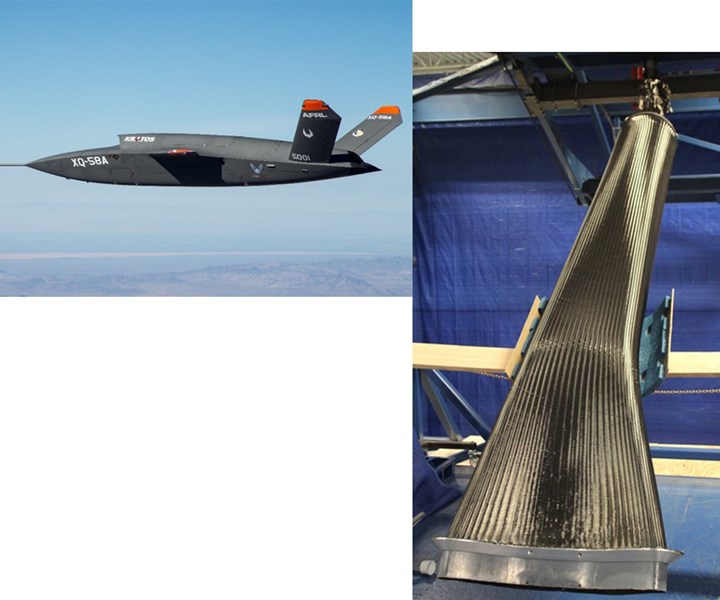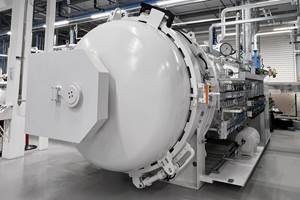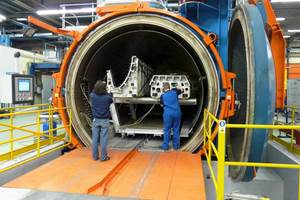AFRL evaluates braiding, SMP tooling and VARTM for lower-cost future engine inlet ducts
U.S. Air Force and Ohio-based composites team develop new process for S-shaped aerostructure.

An 11-foot long inlet duct preform is shown prior to resin infusion, part of a U.S. Air Force Research Lab (AFRL) program to lower costs for UAS like the Kratos XQ-58 Valkyrie (shown here) designed and built by Kratos Defense & Security Solutions for the U.S. Air Force Low Cost Attritable Strike Demonstrator program, under the AFRL’s Low Cost Attritable Aircraft Technology project portfolio. SOURCE | U.S. Air Force
Part of the U.S. Air Force 2030 Science and Technology strategy includes the mass deployment of low-cost Unmanned Aerial Systems to assist in future engagements. To realize this vision, new manufacturing strategies must be identified which can support the rapid manufacturing of high-quality aerospace components at lower costs than what is currently available using legacy processes.
The Air Force Research Laboratory’s (AFRL, Dayton, Ohio, U.S.) Manufacturing and Industrial Technologies Division and the Ohio, U.S.-based contractor team of Cornerstone Research Group (Dayton), A&P Technology (Cincinnati) and Spintech LLC (Xenia), conducted research to quantify the benefits of replacing legacy prepreg hand layup with dry fiber braided preform and vacuum assisted resin transfer molding (VARTM) for the fabrication of an 11-foot long, S-shaped composite engine inlet duct.
Aircraft engine inlet ducts provide a constant supply of air to prevent the engine’s compressor from stalling. The inlet must create as little drag as possible. The smallest gap in airflow supply can cause major engine problems as well as significant efficiency losses. If the inlet duct is to provide sufficient air with minimum turbulence, it must be clean and flawless.
The novel manufacturing approach for the S-shaped inlet duct replaces hand layup prepreg on a multi-piece steel mandrel followed by autoclave cure with an automated overbraid process which instead applies dry fiber. The very heavy multi-piece steel mandrel is replaced with a light-weight single-piece shape-memory polymer (SMP) mandrel. The dry braided carbon fiber is the processed into a composite structure using VARTM with a low-cost epoxy resin and oven cure.
The team completed analysis of the overbraid architecture, as well as fabrication of an SMP forming tool and the SMP mandrel that serves as the tool during the preform overbraiding process. Because of the S-shaped inlet duct’s complex geometry, multiple iterations were necessary to optimize the overbraid machine settings and minimize composite material wrinkling. A total of four inlet ducts will be fabricated and legacy part cost and production time will be compared to the new design.
“We believe that the introduction of a reusable shape memory polymer mandrel together with the automated overbraid process and an oven-based VARTM composite cure will lead to significant cost and cycle time reductions,” says Craig Neslen, manufacturing lead for the Low Cost Attritable Aircraft Technology Initiative in the Manufacturing and Industrial Technologies Division at AFRL. “Quantifying the manufacturing benefits and validating structural integrity will be critical to establishing a positive business case and convincing designers and manufacturers that the new materials and processes should be incorporated into future low-cost engine inlet duct designs.”
The final inlet duct will be delivered to the U.S. Air Force for further integration into the complementary airframe design and manufacturing program within AFRL’s Aerospace Systems Directorate. The Aerospace Vehicles Division will conduct static ground testing of the integrated braided fuselage and inlet duct structure.
“While we have yet to define all of the implications of attrition tolerance on design criteria and the resulting manufacturing materials and processes utilized, we do have a baseline with threshold requirements for strength and stiffness which we will assess via full-scale airframe ground tests,” said Ray Fisher, aerospace engineer in the Aerospace Vehicles Division.
AFRL is the primary scientific research and development center for the U.S. Air Force. It plays an integral role in leading the discovery, development, and integration of affordable warfighting technologies for our air, space, and cyberspace forces. With a workforce of more than 11,000 across nine technology areas and 40 other operations across the globe, AFRL provides a diverse portfolio of science and technology ranging from fundamental to advanced research and technology development. For more information, visit: www.afresearchlab.com.
Related Content
Advanced autoclaves, ovens provide efficiency, precision and intelligent control
CAMX 2025: Olmar is highlighting its next-gen autoclaves and industrial ovens for composites curing to improve throughput, scale production and achieve tighter quality control.
Read MoreIndustrial curing autoclaves with advanced control systems
CAMX 2025: Turnkey Akarmak autoclaves support various composite curing needs with enhanced process control, international specification compliance and optimal heat distribution.
Read MoreBusch expands autoclave solutions
Busch announces its ability to address all autoclave, oven and associated composites manufacturing requirements following the acquisition of Vacuum Furnace Engineering.
Read MorePlataine unveils AI-based autoclave scheduling optimization tool
The Autoclave Scheduler is designed to increase autoclave throughput, save operational costs and energy, and contribute to sustainable composite manufacturing.
Read MoreRead Next
Ultrasonic welding for in-space manufacturing of CFRTP
Agile Ultrasonics and NASA trial robotic-compatible carbon fiber-reinforced thermoplastic ultrasonic welding technology for space structures.
Read MoreCutting 100 pounds, certification time for the X-59 nose cone
Swift Engineering used HyperX software to remove 100 pounds from 38-foot graphite/epoxy cored nose cone for X-59 supersonic aircraft.
Read MoreScaling up, optimizing the flax fiber composite camper
Greenlander’s Sherpa RV cab, which is largely constructed from flax fiber/bio-epoxy sandwich panels, nears commercial production readiness and next-generation scale-up.
Read More












